![]()
![]()
![]()
Use LEFT and RIGHT arrow keys to navigate between flashcards;
Use UP and DOWN arrow keys to flip the card;
H to show hint;
A reads text to speech;
39 Cards in this Set
- Front
- Back
|
Statistics of gunshot wounds
|
-2/3rds of all homicides in the US are caused by firearms
-Non-fatal injuries: 200,000 per year -Deaths by firearms are the second leading cause of non-natural deaths in childhood and adolescence |
|
|
Two main reasons for death by firearms
|
-Availability of weapons
-"Gun culture" |
|
|
Two general classes of firearms
|
-Rifled weapons (handguns, rifles)
-Smooth bore shotguns |
|
|
Characteristics of rifled firearms
|
-Fire one projectile at a time
-Gyroscopic effect, spin: stabilizes bullet in the air -Individual characteristics: leave marks on the bullets that are used to identify the bullet |
|
|
Handguns
|
-Low-velocity weapon
-Muzzle velocity 1400 ft/sec |
|
|
Rifles
|
-High-velocity weapons
-Muzzle velocity for center fire weapon: 4000 ft/sec |
|
|
What really comes from the barrel of a gun?
|
-Flaming gas that travels for a few inches and produces a burn
-Soot that travels for a few more inches (6-7" for most handguns) and produces a soot mark ("smudge") -Unburned powder that travels for up to a few feet (3' usually for a handgun) and produces powder tattooing that will scrape the skin -Bullet that enters or grazes the body |
|
|
Perforating firearm wound
|
-Entrance and exit wound are both present
-Entrance wound is very round -Exit wound is irregular and wider |
|
|
Penetrating firearm wound
|
-Projectile(s) remain in the body
-No exit wound or near exit wound |
|
|
Entrance wounds provide two types of information
|
-Range of fire
-Direction of fire |
|
|
Range of fire
|
-To get a reliable estimate of the range, the particular gun and type of ammunition must be test-fired
-Entrance wounds are classified as: Contact wounds Near contact wounds Medium/Intermediate range wounds Distant wounds |
|
|
Contact wounds
|
-Soot on adjacent skin
-Residues in proximal track -Muzzle imprint -Hard contact wound or loose contact wound |
|
|
Hard contact wound
|
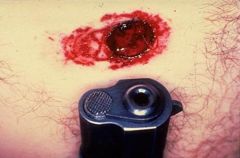
Muzzle pressed against the skin
-Burned edges -Soot embedded in edges -Soot and gunpowder in proximal track |
|
|
Loose contact wound
|
-Temporary gap at discharge
-Soot on adjacent skin -Circular pattern if gun perpendicular to skin -Eccentric pattern if gun at an angle to the skin (broader area of soot on opposite side of muzzle) -Soot and gunpowder in proximal track |
|
|
Near contact wounds
|
-2 to 5 inches
-Muzzle a short distance from skin -Central perforation with circular zone of soot -Eccentric pattern if weapon at an angle (broader area of soot on same side as muzzle) |
|
|
Medium/intermediate range wounds
|
-Presence of gunpowder tattooing adjacent to wound
-1-2 inches gunpowder particles centered around wound, with broader area of soot deposition -6-7'' (15-18 cm), amount of soot decreases, abundant gunpowder present -With increasing muzzle-target distance, zone of distribution of tattooing increases and density of particle dispersion decreases |
|
|
Distant wounds
|
-2 to 4 feet for most handguns
-2 to 3 feet for center fire rifles -No soot or gunpowder deposition |
|
|
Direction of fire
|
-"Abrasion collar"
-Circular, of uniform width, if bullet strikes perpendicularly -Eccentric if bullet strikes at an angle |
|
|
Exit wounds
|
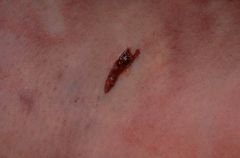
-Larger, more irregular than entrance wounds:
-No abrasion collar -Stellate -slit-like -shored (may cause confusion with entrance wound) |
|
|
Atypical gunshot wounds
|
-Graze wounds when bullet strikes at a shallow angle and abrades the surface of the skin
-More than one projectile -Tangential wound -Therapeutic intervention -Wounds of palms and soles -Wounds of the head -Re-entry wounds |
|
|
Tangential wound
|
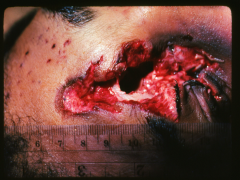
-Bullet strikes at shallow angle
-Tears the skin, creating an elongated wound -Tears along the margins point to the direction of the bullet |
|
|
Therapeutic intervention
|
-Shape of the wound can be distorted
-Residues can be difficult to interpret |
|
|
Wounds of palms and soles
|
-Usually stellate
-No abrasion collar |
|
|
Wounds of the head
|
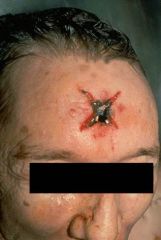
-Entrance wound often stellate
-Bevelling of cranial bone allow for differentiation between entrance/exit wound -"Keyhole" gunshot wound |
|

Entrance? Exit? How was this person shot?
|
-Entrance on the left because of the smooth edges
-Exit on the right with external bevelling -"Keyhole" entrance -Bullet grazed side of head |
|
|
Diagram to show difference between range of fire and entrance/exit wounds
|
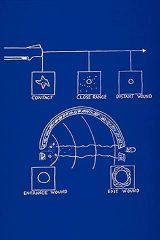
|
|
|
Re-entry wounds
|
No abrasion collar
|
|
|
Entrance wounds from smooth-bore weapons/shotguns
|
-Vary in size and shape depending upon the distance between the muzzle of the gun and the target:
-Round perforation -Wound with scalloped margins -Large wound with satellite small perforations -Multiple small perforations |
|
|
Range of fire from smooth-bore weapons/shotguns
|
Provided by:
-Presence or absence of residue -Penetration or absence of penetration of wads -Appearance of Entrance wound |
|
|
Contact wound from smooth-bore weapons/shotguns
|
-Circular wound, the shot penetrates as a single mass
-Hard contact: muzzle imprint -Loose contact: soot on adjacent skin. -Soot and gunpowder in proximal track -Wads and plastic cup in the wound |
|
|
Intermediate range wounds from smooth-bore weapons/shotguns
|
-Powder tattoing on skin around entrance wound
-Tattoing can occur up to a distance of 30-40" (60-75 cm) -"Cookie-cutter"appearance of wound edges, at 3 feet -Satellite pellets holes around entrance at 4 feet -Wads in wound track -"Petal marks" from open plastic wad at 12-36" (30-90 cm) |
|
|
Distant wounds from smooth-bore weapons/shotguns
|
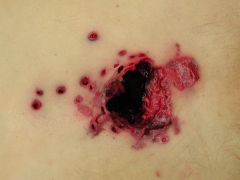
- Number of individual pellet holes increases
-Size of main entrance decreases -Wad does not penetrate but can strike body (5-8 ft, 150-240 cm) -No wad imprint beyond 8 ft |
|
|
Determination of direction of fire from smooth-bore weapons/shotguns
|
-Circular, symmetrical wound , if coming at right angle
-Elliptic wound if coming at an angle -Shelving of edges, undercutting of margin opposite direction of shot |
|
|
Exit wounds from smooth-bore weapons/shotguns
|
-Very large wounds in head, neck, small individuals
-Otherwise, uncommon |
|
|
Internal injuries caused by rifled ammunition
|
-The more kinetic energy lost in the tissue, the greater the damage
-Tissue factor: -Specific gravity and elasticity play a role -The greater the specific gravity, the greater the damage |
|
|
Internal injuries caused by low-velocity weapons
|
-Injury by crushing and punching
-Injury limited to tissue along track |
|
|
Internal injuries caused by high-velocity weapons
|
-Large temporary cavity
-Outstretching of tissue behind bullet -Injury at distance from bullet track |
|
|
Internal injuries caused by shotgun ammunition
|
Damage is due to direct mechanical disruption
|
|
|
Bullet wound deaths are caused by...
|
-Hemorrhage, internal or external
-Cardiac or respiratory malfunction/arrest -Brain dysfunction -Infection -Pulmonary Embolism |

